
| Cat Goddesses | 
|
|
Names, List & Pictures of Ancient Egyptian Cat Goddesses for kids Interesting information, pictures and fast, fun facts about ancient Egyptian Cat Goddesses for kids |
|
Cat Goddesses
Discover information and interesting Cat Goddesses. The fast, fun facts about Cat Goddesses includes a list of facts, names, pictures and images of the ancient Egyptian Cat goddesses. The names of most famous of all the cat goddesses were Bastet (or Bast), Sekmet, Mafdet and Tefnut. Bastet was the benign goddess of cats as pets and household cats, but like all other cat goddesses, she was depicted as a war-like goddess in the guise of other big cats. The many cat goddesses of ancient Egypt were represented in the war-like aspect of the lioness, lynx or cheetah and were revered for their powers of protection and their skills as fierce combatants. Whilst there are many cat goddesses, Bastet is the only one represented as a domestic cat. |
|
Cat Goddesses & Cat Mummies
The domestic cats were sacred animals to the cat goddesses and were carefully embalmed after death, and their bodies were interred as cat mummies in sacred cemeteries that were situated near the temples of the cat goddesses. When a cat died the members of the family would shave off their eyebrows as a sign of mourning. Over 300,000 mummified cats were discovered when the temple of the cat goddess Bastet, at Per-Bast, was excavated. Domestic cats were seen as valued members of the family and were even depicted on tomb paintings. 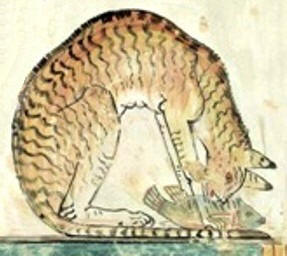
Tomb painting of a domestic cat eating a fish |
|
Facts and Names of Egyptian Cat Goddesses
The following chart, or fact sheet, details interesting information about the names and facts about ancient Egyptian Cat Goddesses. The Fact Sheet details many facts and fascinating pieces of interesting information, history, mythology and legends about the deities and Cat Goddesses of ancient Egypt. 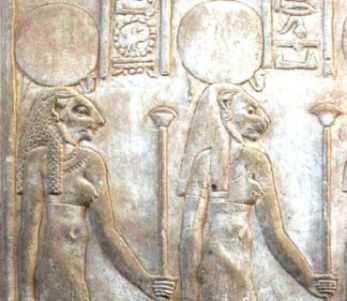
| Names of Egyptian Cat Goddesses | |
|
Bastet: |
Bast or Bastet giver of blessings to the good and a deliverer of wrath to the evil. Protector of the domestic, or household, cats.
| | Mihos: | Mihos was the name of the lion-headed son of Bastet.
| | Sekhmet: | Sekhmet, the warrior lioness goddess, the "Powerful One". Her son, Nefertem, god of perfumes, also had a warlike aspect and could be depicted as a lion
| | Tefnut: | Tefnut and her twin Shu were also worshipped as a pair of lions at Leontopolis
| | Mafdet: | Mafdet, the first of the cat goddesses. She was ancient Egyptian lynx, lion or cheetah shaped war goddess, a cat goddess of protection, spitting fire at cobras. She was the original cat deity who killed the enemy of Ra, the monstrous serpent Apep. She was called the "Runner"
| | Mau: | Mau, the ancient Egyptian word for cat, a personification of the sun god Ra, as a cat who killed Apep
| | Mekal: | Mekal was the "fierce devourer" and a goddess of pestilence adopted from Canaan
| | Pakhet: | Pakhet, "She Who Scratches", was a big cat goddess who protected the living and the dead from evil
| | Menhit: | Menhit was an Egyptian war goddess, depicted in the form of a lioness who sometimes wore the red crown of Lower Egypt
| | Matit: | Matit was a funerary cat goddess who had a cult center at Thinis
| | Mut: | Mut the great Mother Goddess was merged with Wadjet, Bastet, Menhit and Sekhmet, who were all warrior lioness goddesses.
| | Mut: | Sesmu, the lion god of slaughter and execution
| | Wadjet: | Wadjet was primarily a cobra goddess, similar in some respects to Meretseger, but she was also depicted in her aspect of a lion-headed goddess |

Picture of the goddess Wadjet as a lion-headed goddess Famous Egyptian Cat Goddesses
The most famous of all the cat goddesses were Bastet (or Bast), Sekmet, Mafdet and Tefnut. The cat goddess Bastet represented both the home and the domestic cat and also the war-like aspect of a lioness, lynx or cheetah. Her cult was centered on her sanctuary at Bubastis. Bastet was credited with killing the Evil Serpent god Apep. Sekhmet was usually depicted in human form with the head of a lioness and crowned by the solar disk, confirming her association with the sun god Ra. Sekhmet was called "The Powerful One" and said to breathe fire at the enemies of the pharaoh. Mafdet, she who runs swiftly, was an early deification of legal justice in the form of executions and was believed to make rulings at judgment hall in the Underworld (Duat) where enemies of the pharaoh were decapitated with the claw of Mafdet. She was depicted in a variety of cat forms including a cheetah, a lynx, a panther or a leopard. Tefnut the Lioness Goddess was worshipped in the famous lion sanctuary at Leontopolis. 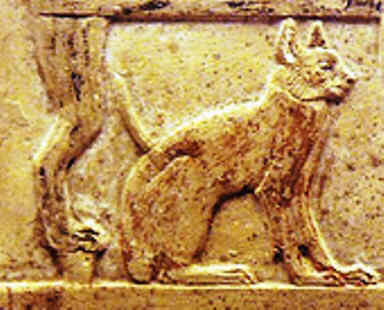
| 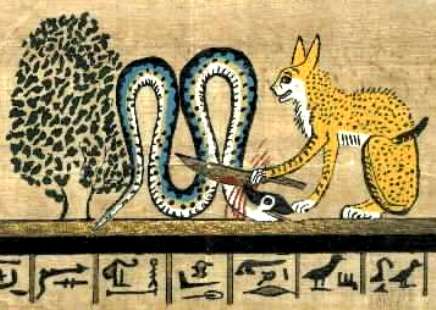
| Bas relief of Bastet at Thebes | Cat Goddess killing the evil snake god Apep |
The Cat Temples at Leontopolis
Leontopolis was famous as the cult center of the lion gods and cat goddesses. Leontopolis was the name of the ancient city where all the lion-headed and cat-headed gods associated with Ra the sun god were worshipped. Leontopolis was located in the central area of the Nile delta. The ancient Egyptian name for Leontopolis was Taremu. 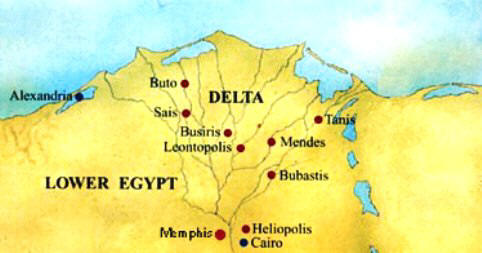
The Greek name of this city means, "City of Lions" as there were many temples dedicated to cat goddesses and lion gods and deities which contained live lions and cats. Aelian (ca. 175 – ca. 235), an ancient Roman historian wrote: "In Egypt, they worship lions, and there is a city called after them. The lions have temples and numerous spaces
in which to roam; the flesh of oxen is supplied to them daily and the lions eat to the accompaniment
of song in the Egyptian language" The Lion gods worshipped at Leontopolis were mostly associated with the cults of the solar god Atum Ra or Ptah. The names of other lion gods worshipped at Leontopolis were Bastet, Sekhmet, lioness of war, and Mihos (Maahes), the lion prince. Leontopolis was also associated with the Horus, who according to ancient Egyptian mythology changed himself into a lion. The feline goddess Tefnut, the twin-sister of Shu, were worshipped as a pair of lions at Leontopolis 
Egyptian Cat Goddesses - The Sphinx
The protective powers and fierce fighting abilities of the cat goddesses were reflected in one of the most iconic symbols of Egypt - the Sphinx. The sphinx was a mythical creature depicted in large stone statues with the body of a lion and the head of a human that often guarded the avenues and temple precincts of the ancient Egyptian gods. Statues of Cat Goddesses
Statues to lion gods and cat goddesses in a protective stance were placed as guardians to the temples of cat goddesses, as seen in the following image. 
| 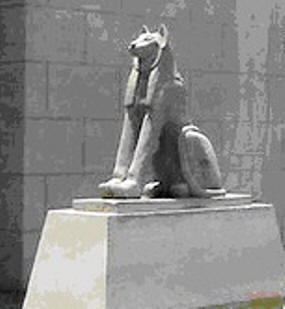
| Picture of Sekmet | Picture of protective Cat Goddess |
|
|
Cat Goddesses- Interesting information and Facts about lion Goddesses
- Facts about ancient lion Goddesses
- History and Egyptian Mythology associated with Facts about lion Goddesses
- Information and about Facts about lion Goddesses for schools, research and kids
- Lion Goddesses and the religion of ancient Egypt
|
| | |
|
Egyptian Cat Goddesses and the Underworld
Cat or Lion headed gods were believed to guard certain halls and gates in the Underworld. Lion gods and goddesses are therefore associated with the dead and the Underworld (Duat). The heads of biers depicted the head of a lion or lioness. The foot of biers were often ornamented with a cat's tail. A bier is movable frame on which a coffin, or a corpse, is placed before burial on which it is carried to the grave. 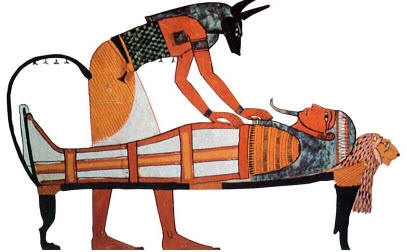
Facts about ancient Cat Goddesses
This chart and Fact Sheet containing Facts about Egyptian cat goddesses provides interesting information, history, mythology and religion surrounding the Lion gods and Goddesses and some of the potent symbols that were associated with the feline deities of ancient Egypt. History, Mythology and Facts about Cat Goddesses | | Fact 1 about Cat Goddesses: | Egyptians believed that the journey through the Underworld brought them from the "Jaws of the lion in the West" to the "Jaws of the lion in the East".
| 
| | Fact 2 about Cat Goddesses: | Cats represented the soothing power of sleep and their beds and headrests were decorated with the heads of big cats
| | Fact 3 about Cat Goddesses: | Pet lions and big cats were kept by the kings and pharaohs of Egypt as symbols of the sun god Ra for their powers of protection who also symbolized fierce combatants
| | Fact 4 about Cat Goddesses: | The lioness was seen as a destroyer who annihilated the enemies of Egypt
| | Fact 5 about Cat Goddesses: | The lion devoured the enemies of the gods and spat them out
| | Fact 6 about Cat Goddesses: | Male big cats were depicted, in their protective role, crouching on the roofs of temples
| | Fact 7 about Cat Goddesses: | The cat was a sacred animal and any person who killed a cat in ancient Egypt, either intentionally or unintentionally, was sentenced to death.
| | Fact 8 about Cat Goddesses: | The earliest cat goddess recorded was Mafdet and described in the Pyramid Texts as killing a serpent with her claws
| | Fact 9 about Cat Goddesses: | Every home in Bubastis would have a small shrine to the goddess Bastet as a protector of the household.
| | Fact 10 about Cat Goddesses: | The domestication of cats in ancient Egypt is believed to date as far back as 3000BC. The first domesticated Egyptian cats were used for warding off snakes and rodents.
|
Offerings to the Cat Goddesses
The following picture shows a temple scene in which a cat goddess is being worshipped. The lotus flower, features strongly in the picture, as does the incense burner. Incense offerings were made on a daily basis and scent played such an important part in temples, daily life and magical rituals. Only priests, priestesses and royalty were allowed inside temples. Ordinary Egyptians worshipped and made offerings at small shrines in their homes. A statue of the cat goddess might have been placed on the altar table and ancient Egyptians prayed and gave offerings to the god whilst kneeling on a reed mat. 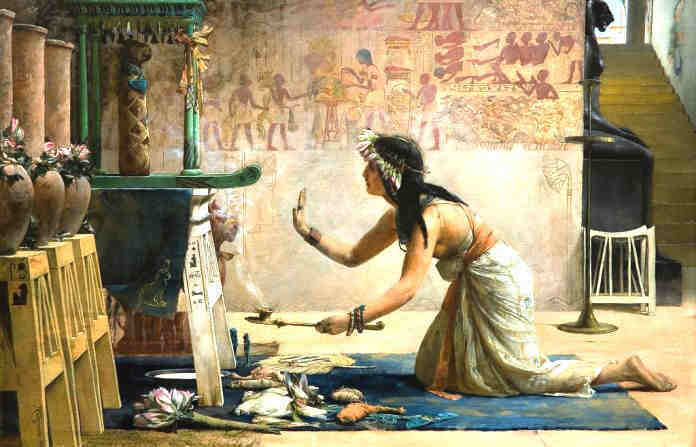
|
|
|
|